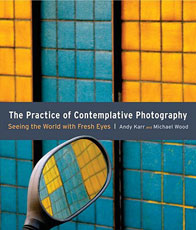"The meaning of life is to see," said the seventh century Zen sage Hui Neng. The problem is that many of us don't want to slow down and take the time needed to truly be present wherever we are. "Hurry sickness" is one reason we are seeing less and less of the world around us. The other problem is that we are so plugged into our technological toys that we experience the beauty and the mystery of the natural world only as a meaningless backdrop for our experiences in our virtual cocoons. Andy Karr and Michael Wood are photographers and Buddhist meditators who have created this top-drawer resource on contemplative photography; it is filled with examples of their photographs to illustrate their concepts.
This book is designed to engender within you a new way of taking photographs and a new way of seeing. The authors note that the word contemplate means "to be present with something in an open space." This requires letting go of mental activity that obscures our awareness. The photograph is a mirror of your state of mind. Your creativity combined with clear seeing produces the contemplative image.
"Ordinary experience is the raw material of our photographic art," write Karr and Wood. We live in a multidimensional wonder-world and there isn't a moment to waste. The authors outline the three steps of seeing and the contemplative state of mind: (1) connecting with the flash of perception, (2) working with visual discernment, and (3) forming the equivalent of what we have seen. Karr and Wood recommend going out with our cameras two or three times a week to practice. They then set up a color assignment with explicit instructions and a sampler of the work they and friends and students have done with color. Being present is a major factor in this assignment.
Next comes a 20-shot examination of odd things to help us overcome boredom. Karr and Wood explain: "With an open heart, you will appreciate more, and this will give you more to share through your photographs." Other assignments include exploring texture, simplicity, working with light, and seeing space. They conclude with:
"Seeing things as they are is also accepting them as they are, which leads to appreciating them as they are. This is the way to equanimity and a sane and meaningful life. We may not always be able to get what we want and avoid what we don't want, but by letting go of some of our ideas about these things, we can experience them fresh and lead a life with heart."
